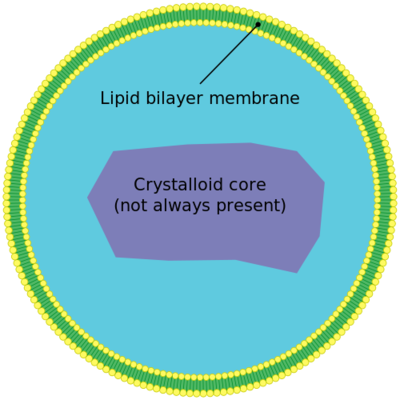Peroxisome
|
|
Peroxisomes are ubiquitous organelles in eukaryotes. They consist of a single membrane that separates them from the cytosol (the internal fluid of the cell). Peroxisomes were discovered by Christian de Duve in 1965. Unlike lysosomes, which are formed in the secretory pathway, peroxisomes usually self-replicate by enlarging and then dividing, although there is some indication new ones may be formed directly. They also have membrane proteins that are critical for various functions, such as for importing proteins into their interiors and to proliferate and segregate into daughter cells.
Peroxisomes function to rid the cell of toxic substances, such as hydrogen peroxide, or other metabolites and contain enzymes concerned with oxygen utilization such as D-amino acid oxidase and urease oxidase. The peroxisome contains the enzyme catalase which converts H2O2 (hydrogen peroxide, a toxic byproduct of cellular metabolism) to H2O and O2, with 4H2O2 → 4H2O + 2O2.
In humans, high numbers of peroxisomes can be found in the liver, where toxic byproducts are known to accumulate. All of the enzymes found in a peroxisome are imported from the cytosol. Each enzyme transferred to a peroxisome has a special sequence at one end of the protein, called a PTS or peroxisomal targeting signal, that allows the protein to be taken into that organelle, where they then function to rid the cell of toxic substances.
Peroxisomes also degrade fatty acids and toxic compounds and catalyze the first two steps in the synthesis of ether phospholipids, which are later used to build membranes. Peroxisomes are responsible for oxidation of long-chain fatty acids and thereby generating acetyl groups.
See Also
- Zellweger syndrome, a peroxisomal disease
This article contains material from the Science Primer (http://www.ncbi.nlm.nih.gov/About/Primer) published by the NCBI, which, as a US government publication, is in the public domain [1] (http://www.ncbi.nlm.nih.gov/About/disclaimer.html).
| Organelles of the cell |
|---|
| Chloroplast | Mitochondrion | Centriole | Endoplasmic reticulum | Golgi apparatus | Lysosome | Myofibril | Nucleus | Peroxisome | Ribosome | Vacuole | Vesicle |

